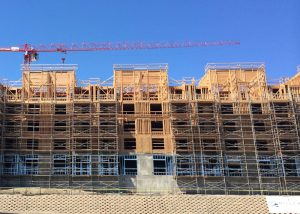
Two-Stage Analysis Procedure of ASCE 7-10
“Podium style” construction lends itself to the “Two-Stage Analysis Procedure” of ASCE 7-10 Section 12.2.3.2. The Two-Stage Analysis Procedure allows structures having a flexible upper portion above a comparatively stiff lower portion to be designed as separate structures with fixed bases, provided several given conditions are met. Have you seen the newly added Item (e)? It reads as follows:
12.2.3.2 Two Stage Analysis Procedure
A two-stage equivalent lateral force procedure is permitted to be used for structures having a flexible upper portion above a rigid lower portion, provided the design of the structure complies with all of the following:
a. – d…..
e. The upper portion is analyzed with the equivalent lateral force or modal response spectrum procedure, and the lower portion is analyzed with the equivalent lateral force procedure.
Here is a frequently asked question on new Item (e):
Q: I have a question regarding two-stage analysis and was hoping that you would be able to clarify this for me. I noticed that in ASCE 7-10 Section 12.2.3.2 Two-Stage Analysis Procedure, Item (e) was added and it forces you to analyze the lower portion using the Equivalent Lateral Force Procedure (ELF). It looks like I cannot use the modal response spectrum procedure for the analysis of the lower structure (which means, I cannot get the benefit of using 85 percent of the calculated base shear per Section 12.9.4). I understand that the structure is stiff, but that shouldn’t mean we cannot use a dynamic analysis. Why do you suppose we cannot use a dynamic analysis? This would have to be a first, where the code is restricting the use of dynamic analysis over ELF; I thought dynamic analysis was always an option. Can you please shed some light on this situation?
A: When Item (e) was added to Section 12.2.3.2 in ASCE 7-10, it was because questions had arisen as to whether dynamic analysis was permitted as part of two-stage analysis, or whether we were restricted to equivalent lateral force analysis only. The Seismic Subcommittee of ASCE 7 decided to make it explicitly clear that modal response spectrum analysis was permitted for the upper portion. The modal analysis procedure cannot be done accurately for the lower structure, since it would require the stiffness and mass distribution of the upper structure to be included in the model. That explains the remainder of Item (e), which you are questioning. There is no exception that I know of. And yes, you are correct, this is an isolated case where the standard mandates ELF and does not allow dynamic analysis to be used.